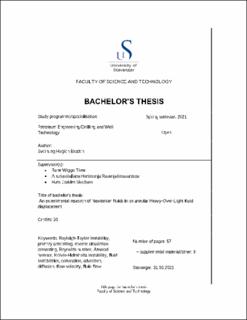| dc.contributor.advisor | Time, Rune Wiggo | |
| dc.contributor.advisor | Skadsem, Hans Joakim | |
| dc.contributor.advisor | Rabenjafimanantsoa, Andrianifaliana Herimonja | |
| dc.contributor.author | Bratten, Sveinung Huglen | |
| dc.date.accessioned | 2021-09-07T16:31:35Z | |
| dc.date.available | 2021-09-07T16:31:35Z | |
| dc.date.issued | 2021 | |
| dc.identifier | no.uis:inspera:78834598:36717699 | |
| dc.identifier.uri | https://hdl.handle.net/11250/2774461 | |
| dc.description.abstract | During the construction of a well, casings are considered essential for the wellintegrity. The job of securing the casing in place, i.e. the primary cementingof the casing, is a challenging task in itself due to the vast amount factors thatcome into play. There are several ways of cementing a case in place, but theyall have the same main goal; to securely displace the drilling fluid and replaceit with a heavier cement slurry. For the cement to be able to provide the bestpossible structural support, and to prevent any leakage, it is critical that it isnot exposed to a large amount of mixing with another fluid. Reverse circulationis one of the techniques used today to ensure a good primary cementing. It hasbeen proven[1] [2] that this method of displacement brings several benefits. Italso provides us with a complex problem in which the heavier cement slurry isplaced on top of the lighter drilling fluid.
In this study we will continue Camilla Bjørnsens (2020) work on density-unstabledisplacement of Newtonian fluid in an annular space. With an improved exper-imental setup and a larger interval of data we can confirm some of her work andalso add new knowledge to the topic. With the use of a camera, density-unstableinterfaces with an At of 0.0035, 0,01 and 0,02 in a system exposed to the outletflow of 0, 10, 20, and 40mm/s has been documented. When keeping the Atwoodnumber constant and only changing the flow rate, one can see that a larger flowrate introduces less backflow and overall mixing, as well as more time efficientdisplacement. The convection term of the system then seems to become themore dominant factor. When keeping the flow velocity constant, and changingthe Atwood number, we see something interesting. At a lower Atwood numberthere seems to be less backflow than an increased Atwood number. This is dueto the now heavier fluid sinking faster into the lighter fluid, pushing it back up.A higher Atwood number also seems to introduce more spin in an eccentric an-nulus. Similar to an increased flow velocity, an increase in the Atwood numberwill also result in a more time efficient displacement. | |
| dc.description.abstract | During the construction of a well, casings are considered essential for the wellintegrity. The job of securing the casing in place, i.e. the primary cementingof the casing, is a challenging task in itself due to the vast amount factors thatcome into play. There are several ways of cementing a case in place, but theyall have the same main goal; to securely displace the drilling fluid and replaceit with a heavier cement slurry. For the cement to be able to provide the bestpossible structural support, and to prevent any leakage, it is critical that it isnot exposed to a large amount of mixing with another fluid. Reverse circulationis one of the techniques used today to ensure a good primary cementing. It hasbeen proven[1] [2] that this method of displacement brings several benefits. Italso provides us with a complex problem in which the heavier cement slurry isplaced on top of the lighter drilling fluid.
In this study we will continue Camilla Bjørnsens (2020) work on density-unstabledisplacement of Newtonian fluid in an annular space. With an improved exper-imental setup and a larger interval of data we can confirm some of her work andalso add new knowledge to the topic. With the use of a camera, density-unstableinterfaces with an At of 0.0035, 0,01 and 0,02 in a system exposed to the outletflow of 0, 10, 20, and 40mm/s has been documented. When keeping the Atwoodnumber constant and only changing the flow rate, one can see that a larger flowrate introduces less backflow and overall mixing, as well as more time efficientdisplacement. The convection term of the system then seems to become themore dominant factor. When keeping the flow velocity constant, and changingthe Atwood number, we see something interesting. At a lower Atwood numberthere seems to be less backflow than an increased Atwood number. This is dueto the now heavier fluid sinking faster into the lighter fluid, pushing it back up.A higher Atwood number also seems to introduce more spin in an eccentric an-nulus. Similar to an increased flow velocity, an increase in the Atwood numberwill also result in a more time efficient displacement. | |
| dc.language | eng | |
| dc.publisher | uis | |
| dc.title | An experimental research of Newtonian fluids inan annular Heavy-Over-Light fluid displacement | |
| dc.type | Bachelor thesis | |
